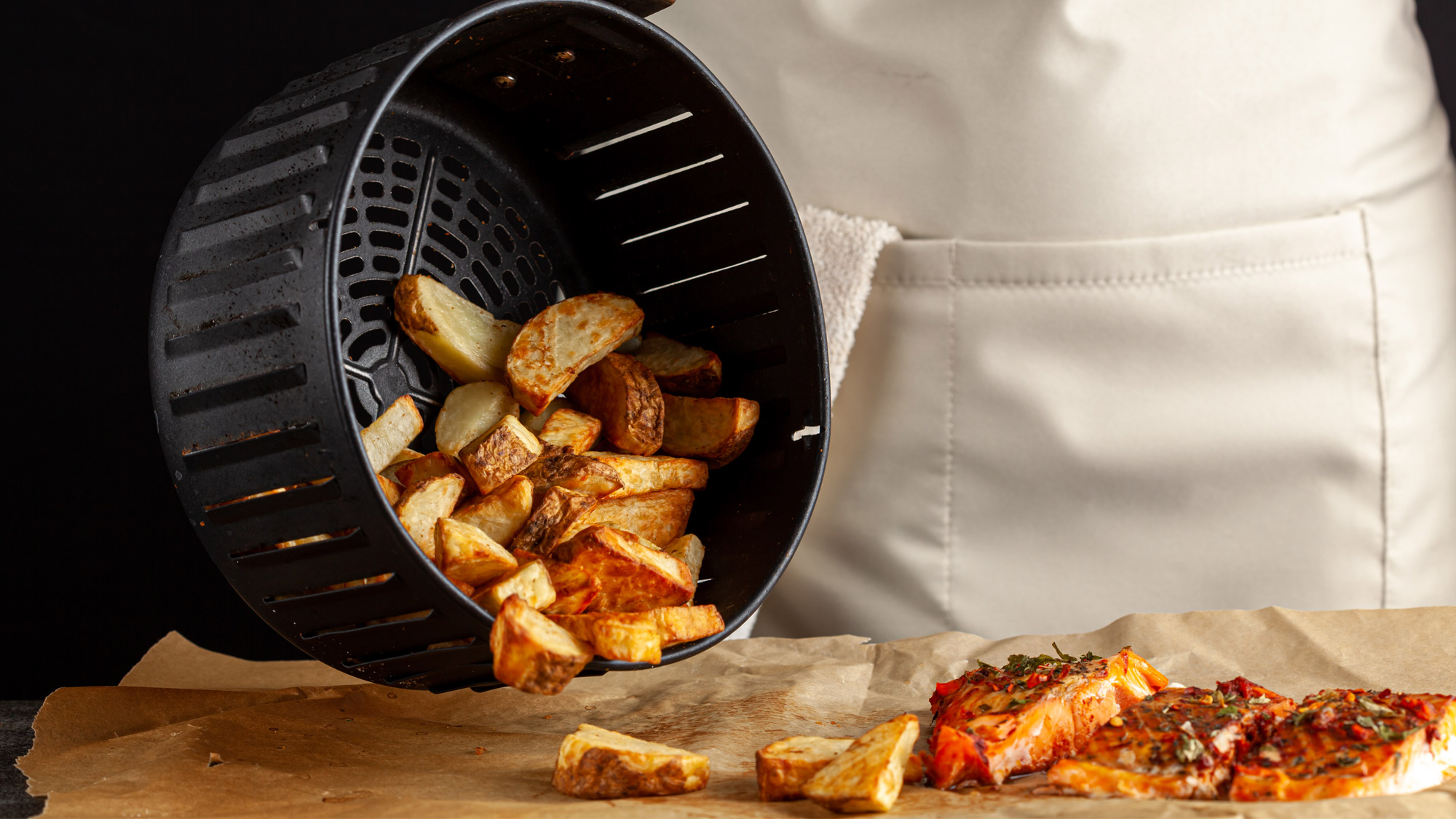Air fryer vs convection oven: which one is the must-have for french fry lovers?
Find out how an air fryer and convection oven differ, and which is best for you

Maybe it’s because we review a lot of kitchen appliances here, but sometimes it feels like you can’t go anywhere these days without someone asking about air fryers. And those someones tend to fall into two different camps. There are the air fryer enthusiasts who want to air fry absolutely everything, and there are the air fryer skeptics who don't see what all the fuss is about. If you're one of the latter, you're probably wondering what's so different about a cooker with a fan inside. After all, isn't that what a convection oven or fan oven is?
And you're right, but there's more to it than that: the best air fryers are actually quite different from countertop convection ovens or built-in fan ovens. And we can prove it through the medium of French fries. As we'll discover, air fryers deliver fantastically fast and crisp results with anything from frozen French fries to roasted vegetables, and that's because they're made in a different way from more conventional ovens. In this feature we'll explain why, what the benefits are and whether it's worth getting an air fryer if you already have a convection oven.
Will the power of fries convert you to the Air Fryer camp? Let's find out!
If you already whether you want an air fryer or a convection oven, check out these best prices for some of our top choices.
Air fryer vs convection oven: What's the difference?
A dedicated air fryer looks very different to a countertop convection oven or toaster oven. It's much smaller, for starters, and it's more likely to look like Darth Vader's helmet than any traditional appliance. Instead of the familiar hinged glass door on the front they have a removable basket or bucket that you take out to check your cooking progress or when the food is ready.
(We say "dedicated air fryer" because some multi-function convection ovens can air fry too, and those ones look pretty much like any other toaster ovens.)
Basket air fryers have, unsurprisingly, a removable basket with a handle built into the front. The food is placed in the basket, which is then inserted into the air fryer to be cooked. Bowl air fryers have a hinged glass, which can be lifted up so food can be placed inside. They also feature a paddle, which moves food around during cooking.
Sign up for breaking news, reviews, opinion, top tech deals, and more.
A countertop convection oven or toaster oven is much bigger, and tends to be shaped like a microwave oven. They usually have a front door with a glass panel so you can see inside, and it's usually hinged on the bottom just like the top oven of a range cooker. Inside you'll find one or more racks for sitting sheet pans on top of, and a fan at the back that circulates hot air. The better the circulation, the more even and faster the cooking.
And that's where dedicated air fryers have the edge. Unlike convection ovens, which are designed to cover all kinds of cooking, air fryers are designed purely to air fry. Their fans are more powerful and sit closer to the food, and their interiors are usually designed to maximise the fan's airflow and deliver more concentrated heat. That means faster, crisper results – but it also means less room for your food, because even the very biggest XL models tend to be smaller than convection ovens.
Air fryers also require food to be shaken or turned halfway through cooking so the hot air can reach every inch of the food, but this isn’t the case with convection ovens.
On the whole countertop convection ovens are also more affordable than air fryers. A top-of-the-range convection oven can set you back up to $150 / £150 /AU$299, while you can pay up to $399 / £299 / AU$499 for an air fryer.
- We find out can an air fryer rival KFC when it comes to fried chicken?
- Discover this air-fryer trick that’s a game-changer for fries
- Find out how an air fryer works
Air fryer vs convection oven: Why are air fryers so popular?
Air fryers have surged in popularity thanks to their speedy cook times and crisp results. Air fryers also require very little preheating, which further speeds up the overall cook time, so you can have dinner on the table far faster than if you're cooking in a convection oven.
Originally touted as the best way to make home-made fries with very little oil, they're now popular for cooking a wide variety of foods. Breaded foods like chicken nuggets or fish will cook with a super crunchy crumb in an air fryer and what's more they'll take less time than in a convection oven. You can also roast vegetables and cook meats like bacon and sausages successfully in an air fryer too.
Air fryer vs convection oven: which does better French fries?
Let's do some science. We took some frozen French fries from a well-known household name and cooked them in three kinds of appliance: a non-fan oven, a convection oven and an air fryer.
The first step was to preheat the appliance to 425ºF for the standard oven and 400ºF for the convection oven, as per the manufacturer's instructions. Air fryers don't need to run so hot so we preheated ours to 375ºF.
Straight away we saw one of the air fryer advantages: because it's got a smaller area to pre-heat and doesn't need to get so hot it was good to go after two minutes. Our countertop convection oven took about six minutes to reach its target temperature and our conventional oven fifteen.
We cooked the fries for the recommended time in both oven and convection oven (14-16 minutes) and for slightly less in the air fryer (11 minutes), turning the fries halfway through cooking – again, as per manufacturer's recommendations. We put the fries on baking sheets for our two ovens and in the standard basket for our air fryer. We gave the air fryer fries a spray of vegetable oil at the beginning and halfway through.
At the end of the cook the results were noticeably different. In the standard, non-convection oven, many of our fries were overcooked and many others undercooked; there wasn't much consistency. In the convection oven the results were much better, although there were some overly browned fries towards the outside. And the air fryer fries were better still, with a consistent golden color – although if we'd left them in for a minute longer, we'd have overcooked them. You need to keep a close eye if you're air frying thin food.
The most important question, though, was how they tasted. And there was no doubt that the air fryer fries tasted best with that just-out-of-the-basket flavor you get from the best deep-fried food. The convection oven was a close second, a little less crispy and a little less tasty, and the standard oven came in a far third: some of its fries were like sticks and others were soggy.
So what explains the difference? More consistent heat is a huge factor, but the air circulation of a mesh basket really helps too: if you want to get better fries without using an air fryer you might want to try a mesh fries basket in your convection oven. That, plus the significantly bigger fan-to-food ratio and the use of a little oil, makes the air fryer the king or queen of fries – or at least, it does if you're not cooking anything else. Our fryer had room for our French fries and nothing else, whereas both ovens also had room for other pans with other foods to cook a complete dinner.
Air fryer vs convection oven: Which should I buy?
Both convection ovens and air fryers are effective when it comes to cooking food quickly, while at the same time creating a crisp, crunchy exterior. However, what you plan to cook in the appliance, and how much countertop space you have, will dictate whether you opt for an air fryer or a countertop convection oven.
Those that are on a budget, and plan on cooking large quantities should consider a convection oven. However, if you plan on mainly cooking fries in the appliance, an air fryer is the way to go. The concentrated heat means the fries have a satisfyingly crunchy, crisp exterior in a short amount of time which is something a convection oven just can’t compete with.
As we’ve already mentioned, consider how much space you have in your kitchen - as convection ovens can be bulky, but they do let you keep an eye on your food - something only bowl air fryers offer.
For further inspiration read our article I’ve used an air fryer for a year - here are five things I learned.
- Check out even more great air fryer deals

Carrie-Ann Skinner was formerly Homes Editor at TechRadar, and has more than two decades of experience in both online and print journalism, with 13 years of that spent covering all-things tech. Carrie specializes in smart home devices such as smart plugs and smart lights, as well as large and small appliances including vacuum cleaners, air fryers, stand mixers, and coffee machines. Carrie is now a copy editor at PWC.